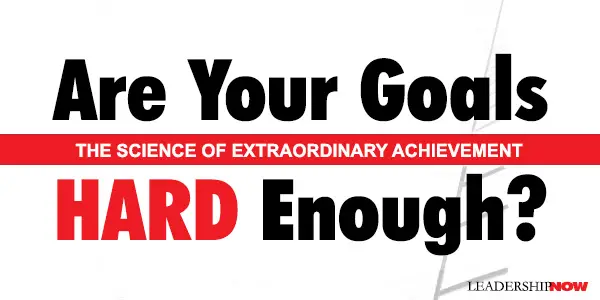 |
 |
12.24.10

Are Your Goals HARD Enough?
ACCORDING to research by John C. Norcross, a clinical psychologist at the University of Scranton in Pennsylvania, only about 45 percent of the subjects managed to stick to their resolutions after six months, and, after a year, that number declines to around ten percent. It’s as Oscar Wilde wrote: "A New Year's resolution is something that goes in one year and out the other.'' The problem, says Leadership IQ CEO Mark Murphy, is that we are trying to execute goals we don’t really care about. The kinds of goals that lead to success “stimulate the brain in profoundly different ways than the goals most people set. In nearly all cases where greatness is achieved, it’s the goal that drives motivation and discipline—not the other way around.” He reports in Hard Goals that in a recent study of over 4000 workers, only 15 percent of them believed that their goals for this year were going to help them achieve great things. And only 13 percent thought their goals would help them maximize their full potential. The solution, says Murphy, is to create H.A.R.D. goals—targets that are:Heartfelt—you’ve got to have an emotional attachment to your goal; it has to scratch an existential itch; you have to develop a heartfelt connection to the payoff.
Every goal you set needs to pass these four tests. Murphy devotes a chapter to each of these four tests. “The overwhelming majority of human beings have tremendous untapped potential but there’s nothing pushing them to access it. Setting goals that are difficult helps unleash the depth of that potential.” Especially helpful is the chapter on the Required part of HARD goals and the need to “alter your view and value of future payoffs so they become more attractive than what the status quo is offering today. You can intentionally move some of the immediate costs of your goal into the future in order to sync up the costs and benefits. Or, conversely, you can bring some of your goal’s future benefits into the present. Both will make your goal look a whole lot more attractive and amp up your urgency to get going on it now.” Inevitably you ask, “Where do I begin once I have my HARD goal?” Murphy suggests you work backwards. First determine the timeframe for your goal—say a year. Then cut it in half and ask, “What must I have accomplished at the six-month mark in order to know that I’m on track to achieve the full HARD Goal?” Then cut that in half and ask, “What must I have accomplished at the three-month mark in order to know that I’m on track to achieve all of my six-month targets?”Continue to cut the time in half until you get to one week and then ask yourself, “What must have I have accomplished today in order to know that I’m on track to achieve all of my one-week targets? Breaking your HARD Goal down into identifiable steps will first, show you exactly where to start. “Second, it monitors and keeps you on track to achieve your HARD Goal (and intensify your efforts where necessary). And third, this exercise shows you that every single day needs to contain some activity in pursuit of your HARD Goal.” Try it this coming year! 
Posted by Michael McKinney at 08:02 AM
|
BUILD YOUR KNOWLEDGE
 

How to Do Your Start-Up Right STRAIGHT TALK FOR START-UPS 
Grow Your Leadership Skills NEW AND UPCOMING LEADERSHIP BOOKS 
Leadership Minute BITE-SIZE CONCEPTS YOU CAN CHEW ON 
Classic Leadership Books BOOKS TO READ BEFORE YOU LEAD |